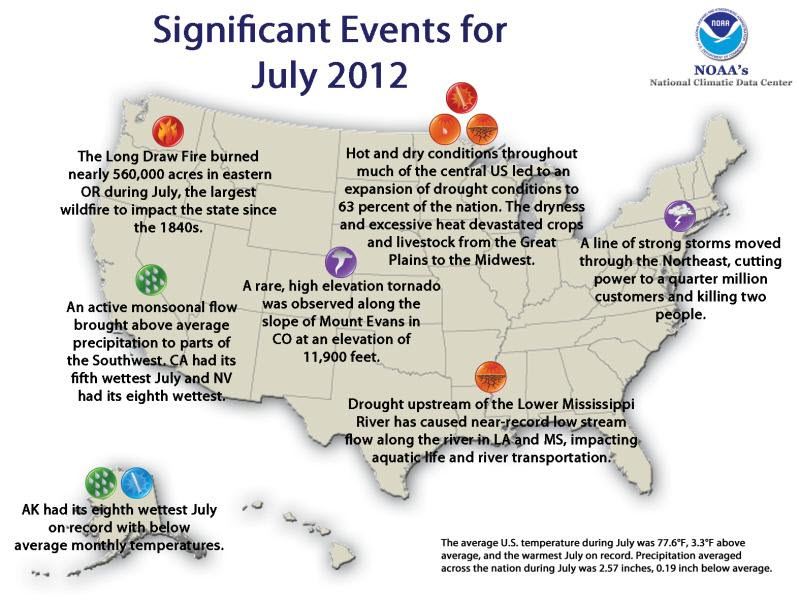The second warmest July on record has finally passed us by, with cooler weather finally finding its way through the midwest and east coast of the U.S. The nights have been seeing temperatures in the 40s, and the day time temperatures have finally hit a high of 80 or less. The cooler weather is quite a relief to many people, as the highs of the 90s or more of July were grueling for many. The agricultural results of 2012 are going to be slim, with the drought and heat that resulted in perishing crops.
Second Warmest July on Record Stats

Image Courtesy of State of the Climate
National Overview
July 2012
National Oceanic and Atmospheric Administration
National Climatic Data Center
Your second warmest july on record is statistically noted as well as the warmest july on record since 1895, when you average all temperatures for the month for the United States. This average, 77.6 degrees Fahrenheit, beats the 1936 average of 77.4 degrees Fahrenheit shows that we are growing towards that 1-2 degree warming that is dangerous for extreme weather results. Warming throughout North America and Northern Europe and Asia, has produced for the first time, no ice in Greenland, which has never been recorded. The warming is extreme for the fact that it reached far outside of normal cool pockets in the United States, or in other parts of the world.
Reviewing other parts of the world, colder than usual temperatures have impacted the world with force and deadly consequences. Chili is experiencing one of the coldest winters on record, and the precipitation has been endless.
Second Warmest July on Record in MN
With the second warmest july on record temperatures being recorded for 2012, there have been many farms and agricultural businesses suffering by high animal feed costs. Meat and other protein stocks are going to become scarce, as the feed stocks have been slaughtered early, and the family roast for the upcoming holiday is going to be very expensive. Meat is going to become a rarity for the American Family, and will be a constant struggle for restaurants, food vendors and grocers. The news of the change of temperature this july is going to result in more than just food scarcity, but a new way of eating for most.
Second Warmest July on Record Produces Drought and Fire
The results of the second warmest july on record in Minnesota has had an impact of creating drought in areas where the Mississippi River is normally high enough to provide good irrigation. As the Minnesota weather was hotter than normal, even in areas where a high of 75 is unusual, the 90-100 degree weather has made a moisture impact. With low moisture high heat in MN, the areas of Iowa, Missouri, Illinois and Ohio have seen a lack of rain, water from the river, and the drought has progressed.
From this as well, without the rain in the center of the country, the Washington and Oregon areas have seen low rain results, and the fires in this area are growing with a rapid rate in August of 2012.
Even with the conservative figure of the second warmest July on record, it was closer to being the warmest july on record for most of the United States, and for the world as well.
